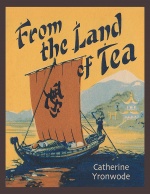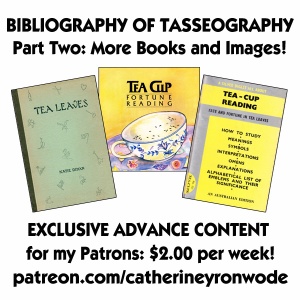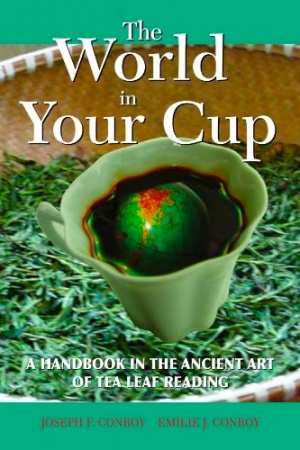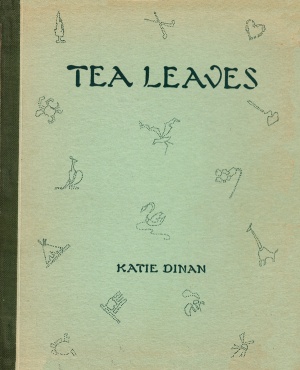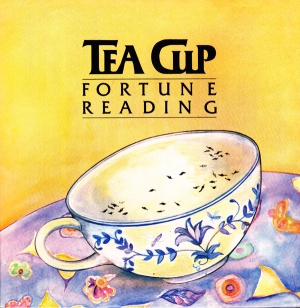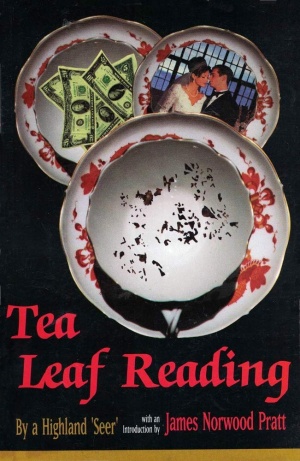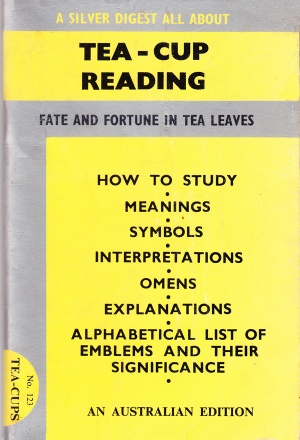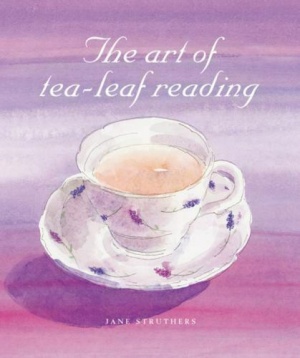Patreon-Bibliography of Books about Tasseomancy-2
From Mystic Tea Room
In this installment of "From the Land of Tea," we take a look at a web page that was funded by my Patreon supporters, who had access to it one full year before the public.
- Patreon Release Date: June 21st, 2022.
- Public Release Date: June 21st, 2023.
Please consider subscribing to my Patreon stream for as little as $2.00 per week:
Patrons: To discuss this and other Patreon projects with me, please join my private Patreon Forum:
Support From the Land of Tea
All of the material you have access to here -- the fabulous tea cups, the instructive booklets, the nostalgic postcards, the boldly graphic matchbook covers, and all of the historical information researched and shared from the mind of the woman who is making it all happen -- can easily fit into one 8 x 10 foot room in an old Victorian farmhouse, but you would never see it without the investment of the time it takes to produce such a site and the caloric input such a site requires in the form of food for the writer, graphic designer, and database manager, as well as the US currency needed to pay for the computers, software applications, scanners, electricity, and internet connectivity that bring it out of that little room and into the world. So, as you can see, this site is the darling of many, and it is growing at a rapid rate ... but although it is "free," there also is a cost. Your financial support underwrites this cost.
Each new web page or sample pdf is circulated to Patrons as an unpublished galley proof or advance copy. After one year access for Patrons, each web page will be released to the public, while book pages will be available to the public as printed books, and copies will be sent to Patrons who subscribe at the upper two tiers.
Patrons have access to a Private Patreon sub-forum within the Lucky Mojo Forum, and will be accorded special Red Star Avatar badges at the Forum.
More Tea Leaf Reading Books!
Last week my Patrons got to see a bit of my collection of books on tasseomancy, with bibliographic information, cover scans, and reviews of the contents of each book.
There were dozens of books last week. This week, i have six more for you. I love making biblipgraphies, and i hope you find this work of help to you in your divination journey.
Please note that this week's page-links are showing up in red and that they lead nowhere. This is because we are in the process of moving or migrating our web sites to a new server and i had to upload this page to a temporary place on another site, rendering the usual relative links inoperable. By the time this page is integrated with the first part of the Tea Leaf Bibliography and both are presented to the public, the links will be working, of course.
Conroy, Joseph F. and Emily J. Conroy. The World in Your Cup: A Handbook in the Ancient Art of Tea Leaf Reading. DNA Press, 2006.
- 140 pages, hardcover with dust-wrapper. The binding itself is burgundy paper over boards with silver foil stamping on the spine.
- Joseph F. Conroy (1945 - ) and Emilie J. Conroy (1981 - ) are a father-daughter team. Joseph F. Conroy is both an author and a literary agent. Emilie J. Conroy is a fiction and non-fiction author and s Pagan clergywoman associated with the Dianic Sisterhood of Themiskyra. Their writing style is exquisite, educational, and altogether charming.
- This book is not quite like any other tea leaf reading manual in my collection. For one thing, the list of tea leaf symbols is very short, and only a one-line meaning is assigned to each of the 96 or so images. Instead, the book delves deeply into other topics. Part One contains a history of tea, a history of tasseomancy, how to brew tea, how to grow your own tea bushes (!), and the equipment needed for reading tea leaves. This occupies 76 pages. The side-trip into how to grow tea plants is a special treasure, and sets this book apart from every other tasseomancy tome. Part Two consists of six chapters on the actual art of tea leaf reading and one chapter on reading coffee grounds. The illustrations are well done, and will help any beginner learn what to look for. Be aware, however, that you may want to acquire a supplementary book with a longer and more detailed list of images.
- This book was published during the second phase of the development of the internet, when web sites became widely available at relatively low cost. There are many links given for suppliers and even for the book itself, but time has rusted a quite few of these and turned them to dust. This is only to be expected, and it does not detract too much from the research that went into the work. Perhaps the Wayback Machine can help, perhaps not. People don't publish long lists of suppliers' URLs these days, with good reason.
Dinan, Katie [Catherine Genevieve Hagen]. Tea Leaves. Avice Dahlin, Publisher, 1949.
- This is a limited edition art book as well as tea leaf reading manual. Each traditional tea leaf symbol is illustrated and each printed illustration is embellished with watercolour designs by the author-artist. The book gives the impression of having been created by a talented Bohemian artist who made and decorated individual copies for her friends.
- The introduction runs from pages v -- xvii and there are 34 numbered pages of tea leaf symbols. Counting all pages, numbered and unnumbered, the book consists of 52 pages. It is bound in stiff pale-green boards. The pages are printed on thick rag art paper and each page is doubled over but uncut. These four leaf / two page fascicles are side stitched and then bound with dark green binder's tape. All text is printed in reddish brown, and additional watercolor art is hand-painted in green.
- There are 5 illustrated tea leaf symbols per numbered page, for a total of 170 images with interpretations.
- Catherine Genevieve Flaherty Hagen (July 21, 1897 - January 21, 1991) was born in Montana. Her mother's maiden surname was Dinan. Catherine was of Irish descent and it seems that her family nick-name was Katie. Like many readers before her, she used her mother's maiden surname to express her female lineage in the world of fortune-telling. She did not trouble to hide her real name, for she placed it in the copyright notice. She was 52 years old when she wrote and illustrated this book. Her death, at the age of 94, was recorded in Contra Costa County, California, that is, in the northern portion of the East Bay Area.
- The book's publisher, Avice Aimee Hall Dahlin (October 10, 1886 - September 24, 1985), listed her place of business as 156 Montgomery Street, San Francisco, California. She was born in California to Daniel Tompkins Hall (1825 - 1893) and Elizabeth (Lizzie) Sims (1864 - 1938). She and her husband, Mr. Dahlin, had one child, Gladys, born in 1911. She was 63 years old when she published this book, which was an obvious labour of hand-craft and artistry. She died in Berkeley, California, at the approximate age of 99.
- 300 copies were made of this book and all were hand-illustrated, numbered, and signed by the author as Katie Dinan. My copy is #288. Rank this among the rarest-of-the-rare ... if you are lucky enough to find a copy. I found mine in Northern California, so it did not travel far from its source.
- I would love to showcase some of the Katie Dinan's artwork, but the book is so tightly bound that it cannot be opened for scanning without breaking the spine or the hinges.
Dynamo House. Tea Cup Fortune Reading. Dynamo House, [n.d.].
- This is a real oddity. It consists of two separate 24 page square-format booklets bound into one colorful board cover, with a bound-in elastic strap to keep the assemblage closed.
- The book is undated but carries an ISBN, which the National Library of Australia estimates to refer to a publication date of 1993-1994. This looks about right to me too, given the graphic and fontagraphic style of the package.
- Interior booklet number one, affixed the front cover, is titled Tea Cup Fortune Reading Notebook. It consists of six pages of grey drawings of a blank tea cup, repeated nine times per page in a grid layout. These pages are headed "Interesting examples." The next six pages are imprinted with nine blank squares per page in a grid pattern, with the header "Recurring symbols. The final 12 pages consist of seven horizontal white spaces in which to write, and are headed "Notes." This is a complete waste of paper.
- Interior booklet number two, affixed the back cover, is titled Tea Cup Fortune Reading. It consists of a nice cover and 6 page introduction to how tea cups are read, followed by about 375 tea leaf symbols on 16 pages in tiny-tiny, but readable type. This 24-page booklet is the entire contents of the book.
Highland Seer, A. Tea Leaf Reading [cover] / Tea-Cup Reading and the Art of Fortune-Telling by Tea-Leaves. With an Introduction by James Norwood Pratt. Privately Published for John Harney and Sons, Ltd. and James Norwood Pratt Tea Luxuries. 1993.
- This is a reprint of the 1917 edition, with a few changes. First, there is the 32-page Introduction by James Norwood Pratt, which conveys a sense of the historical background to the tea trade and to the oracular use of tea. Then follows the original text. The rather inadequate sample cup images of the original have, however, been replaced by ten gloriously photoshopped half-tone images of cups. Finally, there is a 3-page Afrterword by John Harney. of Harney and Sons, Ltd. The book is printed in Canada.
- All in all, if you cannot afford the original edition, which is not rare, merely expensive, i recommend this as the next nest edition. It is not as common as the tiny, square edition with the yellow-gold cover, but its size and layout give you more of a sense of the era in which A Highland Seer was writing.. Pratt's intro is a bit long, and may give the impression of overshadowing the valuable original material, but it is well intentioned and not a bad read in its own right.
Silver Digest. Tea Cup Reading: Fate and Fortune in Tea Leaves. Silver Digest, [n.d.].
- 64 pages, paperback. "An Australian Edition." "Printed by Ross Offset for the publishers Silver Digest Publishing Company, Avalon, N.S.W." "All the Facts in a Few Words ... Little Books of Knowledge."
- True to their name, the Silver Digests were small, saddle-stitched booklets in stiff wraps, printed with silver ink on the exterior and interior cover pages. No other titles are listed, but the topics include Weddings, parties, Speeches, Home Management, Australian Animals, Sydney's Northern Beaches, World Religions, Alcoholism, Choosing a Career, How to Stop Worrying, Family Happiness, How to Be Rich, Memory Training, Phrenology, Yoga, and Witchcraft, to name but a few. This title No. 123 in a series of unknown length. To my American eyes, the Silver Digest series looks like an Australian version of the rackable supermarket checkout line booklets of the 1970s - 1980s. The use f the word "Offset" in the printer's name point to that era as well.
- The book is illustrated with several sample cps and contains the meaning for about 400 tea leaf symbols, all of them traditional and some even antiquated. At least three -- "Aboriginal," "Kangaroo," and "Koala" -- are distinctly Australian.
Struthers, Jane. The Art of Tea-Leaf Reading. Godsfield Press, 2006
- 128 pages, paperback, full colour throughout on glossy paper; heavily illustrated, with art by In addition to the female author and illustrator, the entire masthead consists of women: Executive Editor:, Brenda Rosen,; Editor, Charlotte Wilson; Executive Art Editor, Sally Bond; Designer, Janis Utton; and Production Manager, Louise Hall.
- More than half the book falls into the "lore and romance" category, augmented by instructions on how to conduct a reading. During this section the concept of dividing tea cup readings into special formats is introduced: reading for pets, reading for moving house, reading for romance, career, money and values, reading for health. Once the readings are thus divided, the tea leaf symbols themselves are sorted, and in the approximately 48 pages devoted to listing images, colour-coded pages demarcate the sections on love, wealth, and so forth. After the removal of alphabetization from the list, an end-of-book index must them be produced, and it takes up four pages.
- All things considered, this is a lovely, well-made gift book and serves its purpose admirably, despite the strange idea of chopping the images up by category of reading. Some folks may like that; i found it a bit distracting. However, i liked the book enough to buy it anyway, and to add it to my permanent collection, in large part because it is so pretty.
Thanks to my husband nagasiva yronwode for helping with scans and cleanup. I couldn't have done it without you, dear.
catherine yronwode
curator, historian, and docent
The Mystic Tea Room
